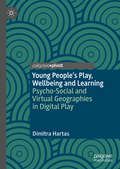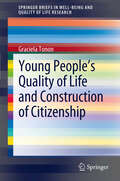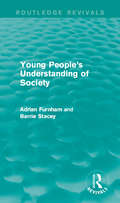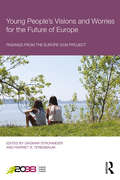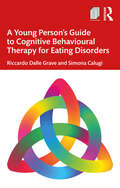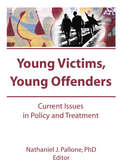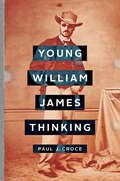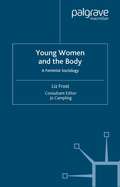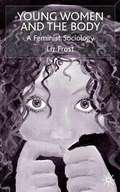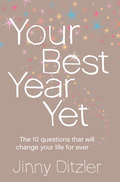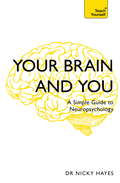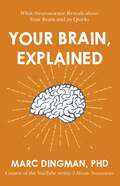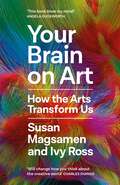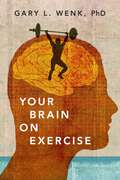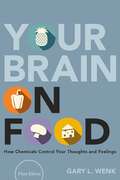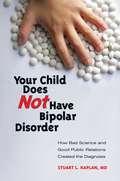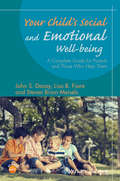- Table View
- List View
Young People's Play, Wellbeing and Learning: Psycho-Social and Virtual Geographies in Digital Play
by Dimitra HartasThis book explores the shifting geographies and contexts of children's play and learning. The author examines both free and guided play through the lenses of class, gender and disability, drawing links between face-to-face and online interactions. As young people increasingly spend time in virtual environments it is important to adjust understandings of how, and when, they engage with learning. The book examines play as a continuum of activities and peer interactions, interrogating what it takes to bridge the gap between academic and wellbeing goals for children with disabilities and disadvantage, as well as those at the intersection with other markers of difference (e.g. gender and race). It will be of interest and value to scholars of play and education, as well as those working with disabled or disadvantaged children.
Young People's Quality of Life and Construction of Citizenship (SpringerBriefs in Well-Being and Quality of Life Research)
by Graciela TononThe study of quality of life refers to the material environment (social welfare) and psychosocial environment (wellbeing). It has been defined as a concept that implies the objective and subjective dimension that Cummins (1997) first studied in seven domains. The use of domains in the quality of life study allows a more precise measurement than the one that could have been reached through simple questions, since psychometric scales are used and if the addition of domains is equivalent to the totality of life satisfaction, then the group of domains is a valid measure of quality of life. In the case of young people, it has been observed that even if they live in negative physical, social and contextual conditions, they can nevertheless experience a relatively positive experience in relation to their quality of life, depending on the strategies and capabilities that they generate in relation to the context. Similarly, young people that live in favorable socioeconomic conditions and with a trouble free psychological situation may experience a relatively poor evaluation of their position in life (Patrick et al). oung people do not form a homogenous group and, in this sense, it is not possible to generalize about youth; they interact with the environment in which they live and they are a product of the history they happen to live, in this way they transit different vital scenarios in daily life that affect their quality of life. The social representations about youth that each population has, in each historical moment, are embedded in the social context in which young people live and develop, conditioning every-day life and /or creating related stereotypes. The concept of youth is a social construction built conjointly by all members of society in the historical moment in which they live. Young people interact with the environment in which they live and they are a product of the history they happen to live. Authors like Urresti (1999) define youth from a point of view that takes into account the living together of different generations in different societies, thus being impossible to compare young people of today with those of two or three decades ago; in addition, he states that it is necessary to situate the understanding of youth within the historical and social moment in which they live. Nowadays the predominant adult model is based in individualism, and even if an intergenerational dialogue is necessary, it is difficult for young people to achieve this kind of communication with adults that, in some cases, are living “stages of youth” or that need to be “forever young”. Young people live in uncertainty, with a limited perspective for future action, assigning their own meaning to events and facts, according to their fundamental concerns that are significantly different from those of their parents’ generation. In the other side the process of globalization and the protagonist social role of the new informational and communicational technologies, produce that the possibilities to expand individual freedoms increase, but not all young people can manage with it (Lechner, 2002). What young people need in order to construct their citizenship and feel satisfied, varies according to the different societies, especially considering that most of them live a fragile situation. As Cortina (2003:7-9) states, the idea of citizenship always transcends individualism, because the citizen is somebody that exists together with others, and those others are equal to him before the city, is somebody that deliberates with others, that acts with others conjointly, that assumes the protagonist role of his own life, in this way citizen is not only that who the law protects, but that who participates in the public issues. Speaking about young people we propose to recognize them from their equal dignity because “recognition is not only a courtesy that we owe others: it is an essential human need” (Taylor, 1993:46). This recognition is based in human dignity and tends to protect the basic rights of people as individuals and to recognize the particul
Young People's Understanding of Society (Adolescence And Society Ser.)
by Adrian FurnhamFirst published in 1991, this book represents the first wide-ranging review of young people’s understanding of the social world and the functioning of society. Taking a social cognitive view of adolescence, it focuses on the processes by which young people learn to understand other people’s thoughts, emotions, intentions and behaviour. Concentrating on the social world of politics, economics, work, gender and religion, the authors cover such issues as: politics and government; work and unemployment; law and legislative matters; religion; marriage and the family; social class; and racial and ethnic differences. This work will be of interest to students of sociology and psychology.
Young People's Understanding of Society (Routledge Revivals)
by Adrian FurnhamFirst published in 1991, this book represents the first wide-ranging review of young people’s understanding of the social world and the functioning of society. Taking a social cognitive view of adolescence, it focuses on the processes by which young people learn to understand other people’s thoughts, emotions, intentions and behaviour. Concentrating on the social world of politics, economics, work, gender and religion, the authors cover such issues as: politics and government; work and unemployment; law and legislative matters; religion; marriage and the family; social class; and racial and ethnic differences. This work will be of interest to students of sociology and psychology.
Young People's Visions and Worries for the Future of Europe: Findings from the Europe 2038 Project
by Dagmar Strohmeier Harriet R. TenenbaumIn a period in which the future of the European Union is subject to increased scrutiny, it is more vital than ever that the thoughts and views of younger generations are considered. Young People’s Visions and Worries for the Future of Europe: Findings from the Europe 2038 Project seeks to do exactly that, presenting the findings of a large-scale research project investigating the opinions and worries of young people between the ages of 16 and 25 across seven European countries. In this unique and timely volume, Strohmeier and Tenenbaum, together with the Europe 2038 consortium, examine young people’s endorsement of multiculturalism, diversity, European identity, human rights, and political participation, and unpick the cross-national differences in a range of European countries. Young People’s Visions and Worries for the Future of Europe concludes by formulating effective evidence-based recommendations for policy and practice. This work is essential reading for advanced level undergraduate and masters level courses in Psychology, Social Work, Politics, Sociology, Social Policy, and Education, as well as researchers in those fields.
Young People's Visions and Worries for the Future of Europe: Findings from the Europe 2038 Project
by Dagmar Strohmeier Harriet R. TenenbaumIn a period in which the future of the European Union is subject to increased scrutiny, it is more vital than ever that the thoughts and views of younger generations are considered. Young People’s Visions and Worries for the Future of Europe: Findings from the Europe 2038 Project seeks to do exactly that, presenting the findings of a large-scale research project investigating the opinions and worries of young people between the ages of 16 and 25 across seven European countries. In this unique and timely volume, Strohmeier and Tenenbaum, together with the Europe 2038 consortium, examine young people’s endorsement of multiculturalism, diversity, European identity, human rights, and political participation, and unpick the cross-national differences in a range of European countries. Young People’s Visions and Worries for the Future of Europe concludes by formulating effective evidence-based recommendations for policy and practice. This work is essential reading for advanced level undergraduate and masters level courses in Psychology, Social Work, Politics, Sociology, Social Policy, and Education, as well as researchers in those fields.
A Young Person’s Guide to Cognitive Behavioural Therapy for Eating Disorders
by Riccardo Dalle Grave Simona CalugiA Young Person’s Guide to Cognitive Behaviour Therapy for Eating Disorders is a state-of-the-art guide for young patients struggling with disordered eating based on enhanced cognitive behaviour therapy (CBT-E). CBT-E is one of the most effective treatments for eating disorders, including anorexia nervosa, bulimia nervosa and binge-eating disorder, which has recently been adapted for adolescents. Written by two experienced clinicians and clinical researchers working daily with teenagers suffering from eating disorders, and their parents, this book offers an effective mix of theory and clinical expertise that will appeal to all readers. The volume starts with a presentation the most current facts on eating disorders. Part 2 then provides young with eating disorders a complete description—accompanied by clinical examples and helpful vignettes on how to implement the main CBT-E procedures. While this book is specifically tailored for young people aged between 15 and 25 years with eating disorders treated with CBT-E, it will also be useful for all young persons affected by eating disorders, and clinicians using CBT-E with young patients.
A Young Person’s Guide to Cognitive Behavioural Therapy for Eating Disorders
by Riccardo Dalle Grave Simona CalugiA Young Person’s Guide to Cognitive Behaviour Therapy for Eating Disorders is a state-of-the-art guide for young patients struggling with disordered eating based on enhanced cognitive behaviour therapy (CBT-E). CBT-E is one of the most effective treatments for eating disorders, including anorexia nervosa, bulimia nervosa and binge-eating disorder, which has recently been adapted for adolescents. Written by two experienced clinicians and clinical researchers working daily with teenagers suffering from eating disorders, and their parents, this book offers an effective mix of theory and clinical expertise that will appeal to all readers. The volume starts with a presentation the most current facts on eating disorders. Part 2 then provides young with eating disorders a complete description—accompanied by clinical examples and helpful vignettes on how to implement the main CBT-E procedures. While this book is specifically tailored for young people aged between 15 and 25 years with eating disorders treated with CBT-E, it will also be useful for all young persons affected by eating disorders, and clinicians using CBT-E with young patients.
Young Victims, Young Offenders: Current Issues in Policy and Treatment
by Letitia C PalloneAt a time when the nation is focused on devising new responses to street crime and on reforming the juvenile justice system, this book brings together in a single volume, current and emerging perspectives on the control of crime by and against children and youth. Young Victims, Young Offenders provides you with an overview of established and emerging practices in treating juvenile offenders and adults who prey on children and youth.This book explores the nature and causes of criminal offenses committed by and against juveniles. While children and youth show up statistically as offenders, they also figure disproportionately as victims. The contributing authors consider both of these aspects as they discuss current programs for the treatment of youths who commit or are victimized by criminal offenses.Topics of a wide range are addressed in Young Victims, Young Offenders for people--like you-- who work with our nation’s youth. A sampling of topics includes: How states address child maltreatment through reporting laws and special courtroom procedures Associations between selected psychosocial variables and chronic delinquency Implications of mandatory Child Abuse Reporting Laws on treating offenders The success of diversion during a 20-year period in a youth service bureau Clinical techniques in the treatment of juvenile sex offenders A study on the effectiveness of an intervention program in Iowa for youthful offendersThis book is useful for the pre-service student pursuing course work in juvenile delinquency, correctional counseling, probation, parole, and social work. At the in-service level, correctional counselors, probation officers, parole officers, social workers, psychologists, psychiatrists, correctional administrators, and child care workers can find much to challenge and enhance their effectiveness in their work with young victims and offenders.
Young Victims, Young Offenders: Current Issues in Policy and Treatment
by Letitia C PalloneAt a time when the nation is focused on devising new responses to street crime and on reforming the juvenile justice system, this book brings together in a single volume, current and emerging perspectives on the control of crime by and against children and youth. Young Victims, Young Offenders provides you with an overview of established and emerging practices in treating juvenile offenders and adults who prey on children and youth.This book explores the nature and causes of criminal offenses committed by and against juveniles. While children and youth show up statistically as offenders, they also figure disproportionately as victims. The contributing authors consider both of these aspects as they discuss current programs for the treatment of youths who commit or are victimized by criminal offenses.Topics of a wide range are addressed in Young Victims, Young Offenders for people--like you-- who work with our nation’s youth. A sampling of topics includes: How states address child maltreatment through reporting laws and special courtroom procedures Associations between selected psychosocial variables and chronic delinquency Implications of mandatory Child Abuse Reporting Laws on treating offenders The success of diversion during a 20-year period in a youth service bureau Clinical techniques in the treatment of juvenile sex offenders A study on the effectiveness of an intervention program in Iowa for youthful offendersThis book is useful for the pre-service student pursuing course work in juvenile delinquency, correctional counseling, probation, parole, and social work. At the in-service level, correctional counselors, probation officers, parole officers, social workers, psychologists, psychiatrists, correctional administrators, and child care workers can find much to challenge and enhance their effectiveness in their work with young victims and offenders.
Young William James Thinking
by Paul J. CroceDuring a period of vocational indecision and deep depression, young William James embarked on a circuitous journey, trying out natural history field work, completing medical school, and studying ancient cultures before teaching physiological psychology on his way to becoming a philosopher. A century after his death, Young William James Thinking examines the private thoughts James detailed in his personal correspondence, archival notes, and his first publications to create a compelling portrait of his growth as both man and thinker.By going to the sources, Paul J. Croce;€™s cultural biography challenges the conventional contrast commentators have drawn between James;€™s youthful troubles and his mature achievements. Inverting James;€™s reputation for inconsistency, Croce shows how he integrated his interests and his struggles into sophisticated thought. His ambivalence became the motivating core of his philosophizing, the heart of his enduring legacy. Readers can follow James in science classes and in personal "speculations," studying medicine and exploring both mainstream and sectarian practices, in museums reflecting on the fate of humanity since ancient times, in love and with heart broken, and in periodic crises of confidence that sometimes even spurred thoughts of suicide. A case study in coming of age, this book follows the famous American philosopher's vocational work and avocational interests, his education and his frustrations;¢;‚¬;€?young James between childhood and fame. Anecdotes placed in the contexts of his choices shed new light on the core commitments within his enormous contributions to psychology, philosophy, and religious studies. James;€™s hard-won insights, starting with his mediation of science and religion, led to his appreciation of body and mind in relation. Ultimately, Young William James Thinking reveals how James provided a humane vision well suited to our pluralist age.
Young William James Thinking
by Paul J. CroceDuring a period of vocational indecision and deep depression, young William James embarked on a circuitous journey, trying out natural history field work, completing medical school, and studying ancient cultures before teaching physiological psychology on his way to becoming a philosopher. A century after his death, Young William James Thinking examines the private thoughts James detailed in his personal correspondence, archival notes, and his first publications to create a compelling portrait of his growth as both man and thinker.By going to the sources, Paul J. Croce;€™s cultural biography challenges the conventional contrast commentators have drawn between James;€™s youthful troubles and his mature achievements. Inverting James;€™s reputation for inconsistency, Croce shows how he integrated his interests and his struggles into sophisticated thought. His ambivalence became the motivating core of his philosophizing, the heart of his enduring legacy. Readers can follow James in science classes and in personal "speculations," studying medicine and exploring both mainstream and sectarian practices, in museums reflecting on the fate of humanity since ancient times, in love and with heart broken, and in periodic crises of confidence that sometimes even spurred thoughts of suicide. A case study in coming of age, this book follows the famous American philosopher's vocational work and avocational interests, his education and his frustrations;¢;‚¬;€?young James between childhood and fame. Anecdotes placed in the contexts of his choices shed new light on the core commitments within his enormous contributions to psychology, philosophy, and religious studies. James;€™s hard-won insights, starting with his mediation of science and religion, led to his appreciation of body and mind in relation. Ultimately, Young William James Thinking reveals how James provided a humane vision well suited to our pluralist age.
Young Women and the Body: A Feminist Sociology
by L. FrostYoung Women and the Body sets out to examine why the current generation of young women seem to be deeply unhappy with their own bodies. Dieting and disguising are commonplace, and inflicting serious harm by no means rare in fourteen to eighteen year olds. Despite prophesies to the contrary boys and adults are suffering far less. Drawing on feminist social constructionist perspectives the book seeks to examine this epidemic of body-hatred.
Young Women and the Body: A Feminist Sociology (PDF)
by Liz FrostYoung Women and the Body sets out to examine why the current generation of young women seem to be deeply unhappy with their own bodies. Dieting and disguising are commonplace, and inflicting serious harm by no means rare in fourteen to eighteen year olds. Despite prophesies to the contrary boys and adults are suffering far less. Drawing on feminist social constructionist perspectives the book seeks to examine this epidemic of body-hatred.
Your Best Year Yet!: Make The Next 12 Months Your Best Ever!
by Jinny DitzlerThe ebook edition of this best-selling book. Your Best Year Yet is the perfect guide to help you realise goals and overcome last year’s limitations. The proven methods in the book will make this year into the most successful ever.
Your Brain and You: A Simple Guide to Neuropsychology
by Nicky HayesMost general knowledge about the brain and its workings is very dated, drawing on studies from the first part of the previous century or even earlier. However, the advent of brain scanning which allows the study of the ordinary working brain, rather than just dead ones or people having brain surgery, has resulted in some amazing new developments that contribute immensely to our general social understanding of people and how they work. Written by Dr Nicky Hayes, bestselling author of Understand Psychology, Your Brain and You is a beginner's guide to neuropsychology. It takes you through every aspect of how your brain works, from nervous systems and brain structures to neural transmission and neural correlates. You will discover how it all began, how it works, how we see, do things, hear and experience the outside world. Explore memories, relationships, emotions, decision-making, sleep, consciousness and common disorders such as dyslexia, dysgraphia & dyscalculia. As with all Teach Yourself books, it is clearly structured, packed full of practical examples, and designed to make it easy to learn the essentials you really need to know.ABOUT THE SERIESPeople have been learning with Teach Yourself since 1938. With a vast range of practical how-to guides covering language learning, lifestyle, hobbies, business, psychology, and self-help, there's a Teach Yourselfbook for everything you want to do. Join more than 60 million people who have reached their goals with Teach Yourself, and never stop learning.
Your Brain, Explained: What Neuroscience Reveals about Your Brain and its Quirks
by Marc DingmanSleep. Memory. Pleasure. Fear. Language. We experience these things almost every day, but how do our brains create them? Your Brain, Explained is a personal tour around your gray matter. Neuroscientist Marc Dingman gives you a crash course in what goes on in your brain and explains the latest research on the brain functions (and malfunctions) that affect you on a daily basis. You'll also discover what happens when these systems don't work the way they should, causing problems such as insomnia, ADHD, depression or addiction, how neuroscience is working to fix these problems, and how you can build up your defences against the most common faults of the mind.Along the way you'll find out:·Why brain training games don't prevent dementia (and what does)· What it's like to remember every day of your life as if it were yesterday· Which mental ailment used to be treated with German rocket fuel· What triggers sleep loss, or lapses in concentrationDrawing on the author's popular YouTube series, 2-minute Neuroscience, this is a friendly, engaging introduction to the human brain and its quirks from the perspective of a neuroscientist - using eye-opening illustrations and real-life examples. Your brain is yours to discover.
Your Brain on Art: How the Arts Transform Us
by Susan Magsamen Ivy RossTHE NEW YORK TIMES BESTSELLER A WATERSTONES BEST BOOK OF 2023 BARNES & NOBLE'S BEST SCIENCE & NATURE BOOKS OF 2023 We’re on the verge of a cultural shift in which the arts can deliver potent, accessible and proven solutions for the well-being of everyone. Magsamen and Ross offer compelling research that shows how engaging in an art project — from painting and dancing to expressive writing, architecture and more — for as little as forty-five minutes reduces the stress hormone cortisol, no matter your skill level, and just one art experience per month can extend your life by ten years. Your Brain on Art is an authoritative guide to how neuroaesthetics can help us transform traditional medicine, build healthier communities and mend an aching planet. The book weaves a tapestry of breakthrough research, insights from multidisciplinary pioneers and compelling stories from people who are using the arts to enhance their lives.
Your Brain on Exercise
by Gary L. WenkAcclaimed neuroscientist Gary Wenk reveals the fascinating impacts of exercise on the brain Decades of research demonstrate that regular modest levels of exercise improve heart and lung function and may relieve joint pain. Regular daily exercise will help your body to regulate blood sugar levels and reduce inflammation, and many of these benefits are a consequence of reducing the amount of body fat you carry around. Your body clearly benefits in many ways from regular exercise. Does your brain benefit as well? Does regular exercise positively affect brain function? Does our thinking become faster because we exercise? Does running a marathon make us smarter? Dr. Gary Wenk's goal is to provide a realistic perspective on what benefits your brain should expect to achieve from exercise. Your Brain on Exercise skillfully blends scholarship with illuminating insights and clarity. Without requiring any specialized knowledge about the brain, Your Brain on Exercise entertainingly illustrates the intersection between brain health, the consequences of exercise, and our need to eat in an entirely new light. An internationally renowned neuroscientist and medical researcher, Dr. Wenk has been educating college and medical students about the brain and lecturing around the world for more than forty years.
Your Brain on Exercise
by Gary L. WenkAcclaimed neuroscientist Gary Wenk reveals the fascinating impacts of exercise on the brain Decades of research demonstrate that regular modest levels of exercise improve heart and lung function and may relieve joint pain. Regular daily exercise will help your body to regulate blood sugar levels and reduce inflammation, and many of these benefits are a consequence of reducing the amount of body fat you carry around. Your body clearly benefits in many ways from regular exercise. Does your brain benefit as well? Does regular exercise positively affect brain function? Does our thinking become faster because we exercise? Does running a marathon make us smarter? Dr. Gary Wenk's goal is to provide a realistic perspective on what benefits your brain should expect to achieve from exercise. Your Brain on Exercise skillfully blends scholarship with illuminating insights and clarity. Without requiring any specialized knowledge about the brain, Your Brain on Exercise entertainingly illustrates the intersection between brain health, the consequences of exercise, and our need to eat in an entirely new light. An internationally renowned neuroscientist and medical researcher, Dr. Wenk has been educating college and medical students about the brain and lecturing around the world for more than forty years.
Your Brain on Food: How Chemicals Control Your Thoughts and Feelings
by Gary L. WenkAn internationally renowned neuroscientist, Dr. Wenk has been educating college and medical students about the brain and lecturing around the world for more than forty years. He has published over three hundred publications on the effects of drugs upon the brain. This essential book vividly demonstrates how a little knowledge about the foods and drugs we eat can teach us a lot about how our brain functions. The information is presented in an irreverent and non-judgmental manner that makes it highly accessible to high school teenagers, inquisitive college students and worried parents. Dr. Wenk has skillfully blended the highest scholarly standards with illuminating insights, gentle humor and welcome simplicity. The intersection between brain science, drugs, food and our cultural and religious traditions is plainly illustrated in an entirely new light. Wenk tackles fundamental questions, including: · Why do you wake up tired from a good long sleep and why does your sleepy brain crave coffee and donuts? · How can understanding a voodoo curse explain why it is so hard to stop smoking? · Why is a vegetarian or gluten-free diet not always the healthier option for the brain? · How can liposuction improve brain function? · What is the connection between nature's hallucinogens and religiosity? · Why does marijuana impair your memory now but protect your memory later in life? · Why do some foods produce nightmares? · What are the effects of diet and obesity upon the brains of infants and children? · Are some foods better to eat after traumatic brain injury?
Your Brain on Food: How Chemicals Control Your Thoughts and Feelings
by Gary L. WenkAn internationally renowned neuroscientist, Dr. Wenk has been educating college and medical students about the brain and lecturing around the world for more than forty years. He has published over three hundred publications on the effects of drugs upon the brain. This essential book vividly demonstrates how a little knowledge about the foods and drugs we eat can teach us a lot about how our brain functions. The information is presented in an irreverent and non-judgmental manner that makes it highly accessible to high school teenagers, inquisitive college students and worried parents. Dr. Wenk has skillfully blended the highest scholarly standards with illuminating insights, gentle humor and welcome simplicity. The intersection between brain science, drugs, food and our cultural and religious traditions is plainly illustrated in an entirely new light. Wenk tackles fundamental questions, including: · Why do you wake up tired from a good long sleep and why does your sleepy brain crave coffee and donuts? · How can understanding a voodoo curse explain why it is so hard to stop smoking? · Why is a vegetarian or gluten-free diet not always the healthier option for the brain? · How can liposuction improve brain function? · What is the connection between nature's hallucinogens and religiosity? · Why does marijuana impair your memory now but protect your memory later in life? · Why do some foods produce nightmares? · What are the effects of diet and obesity upon the brains of infants and children? · Are some foods better to eat after traumatic brain injury?
Your Child Does Not Have Bipolar Disorder: How Bad Science and Good Public Relations Created the Diagnosis (Childhood in America)
by Stuart L. KaplanAn eminent child psychiatrist provides an insider's, whistle-blowing perspective on the promotion of a diagnostic entity that does not exist.Your Child Does Not Have Bipolar Disorder: How Bad Science and Good Public Relations Created the Diagnosis examines this diagnostic fad through a variety of lenses. Author Stuart L. Kaplan, MD, draws heavily on his forty years of experience as a clinician, researcher, and professor of child psychiatry to make the argument that bipolar disorder in children and adolescents is incorrectly diagnosed and incorrectly treated.As Dr. Kaplan explains, the dramatic rise in this particular diagnosis is not based on scientific evidence, nor does it reflect any new discovery or insight about the etiology or treatment of the disorder. In fact, the opposite is the case: the scientific evidence against the existence of child bipolar disorder is so strong that it is difficult to imagine how it has gained the endorsement of anyone in the scientific community.Your Child Does Not Have Bipolar Disorder: How Bad Science and Good Public Relations Created the Diagnosis explains to parents and professionals the faulty reasoning and bad science behind the misdiagnosis of childhood bipolar disorder. Dr. Kaplan critiques the National Institute of Mental Health, academic child psychiatry, the pharmaceutical industry, and the media for their respective roles in advocating this diagnosis. He describes very clearly what the children and adolescents actually do have, explains how it should be treated, and provides real-life clinical scenarios and approaches to treatment that work.
Your Child's Social and Emotional Well-Being: A Complete Guide for Parents and Those Who Help Them
by John S. Dacey Lisa B. Fiore Steven Brion-MeiselsYour Child's Social and Emotional Well-Being provides a practical guide full of proven strategies for promoting social and emotional learning (SEL) skills in children aged 4-16. A practical guide designed to support parents and education professionals in developing social and emotional skills in children, a form of learning that can be neglected in formal education Demonstrates how to foster social and emotional learning (SEL) at home and in the classroom, and shows how parents and professionals can work together for success Includes a wealth of exercises for promoting social and emotional wellbeing, along with tips, tools, and coverage of new developments such as computer-assisted instruction Written by authors with a wealth of practical and writing experience
Your Child's Social and Emotional Well-Being: A Complete Guide for Parents and Those Who Help Them
by John S. Dacey Lisa B. Fiore Steven Brion-MeiselsYour Child's Social and Emotional Well-Being provides a practical guide full of proven strategies for promoting social and emotional learning (SEL) skills in children aged 4-16. A practical guide designed to support parents and education professionals in developing social and emotional skills in children, a form of learning that can be neglected in formal education Demonstrates how to foster social and emotional learning (SEL) at home and in the classroom, and shows how parents and professionals can work together for success Includes a wealth of exercises for promoting social and emotional wellbeing, along with tips, tools, and coverage of new developments such as computer-assisted instruction Written by authors with a wealth of practical and writing experience
